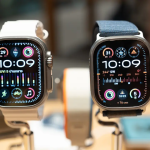Apple is preparing a significant push into artificial intelligence (AI) hardware, unveiling an ambitious roadmap for the next two years. Central to this strategy is the development of innovative AI-powered products, including a tabletop robot, a smart display, and AI-enabled home security cameras—all aimed at revitalizing Apple’s product lineup and deepening its presence in the smart home and AI ecosystem.
Tabletop Robot: The AI Virtual Companion for 2027
The centerpiece of Apple’s AI hardware expansion is a tabletop robot, expected to launch in 2027. This device will feature:
- An iPad-sized display mounted on a movable robotic arm, capable of swiveling and repositioning itself to follow users around a room.
- A redesigned, AI-powered Siri assistant that can engage in multi-person conversations, recall context over time, and offer relevant suggestions.
- Advanced sensors and tracking capabilities to interact meaningfully with users as a virtual companion.
This robot marks a bold step into robotics, showcasing Apple’s vision of AI as a deeply interactive, personable experience beyond traditional devices.
Smart Display: Expanding Apple’s Smart Home Portfolio in 2026
Expected by mid-2026, Apple will launch a smart speaker with a built-in display, codenamed J490. This product will:
- Operate on a new multi-user platform called Charismatic that personalizes the experience through facial recognition.
- Support home automation controls, music playback, videoconferencing, and voice interactions.
- Provide a pivotal AI-enhanced smart home hub experience aligned with Apple’s ecosystem.
The smart display is Apple’s entry-level smart home device intended to compete with offerings like Amazon Echo Show and Google Nest Hub.
AI-Enabled Home Security Cameras
Alongside, Apple is developing AI-driven home security cameras, codenamed J450, equipped with features such as:
- Facial recognition and infrared sensors.
- Automation triggers that can, for example, switch off lights in empty rooms or play preferred music automatically for recognized individuals.
- Long battery life lasting several months on a single charge.
These cameras aim to compete directly with Amazon’s Ring and Google’s Nest, expanding Apple’s footprint in home security products.
Revamped Siri and Advanced AI Software
Apple is undertaking a full overhaul of Siri with two projects:
- Linwood: Powered by Apple’s in-house large language models.
- Glenwood: Testing third-party AI systems including Anthropic’s Claude.
This revamp aims to deliver faster, more personalized responses, natural multi-person conversations, and a redesigned visual Siri interface on iPhones and iPads targeted for release as early as next year.
Broader Product Pipeline and Market Context
Beyond AI-focused devices, Apple’s hardware roadmap includes:
- Smart glasses.
- Foldable iPhones.
- A MacBook–iPad hybrid foldable device.
- Thinner iPhone models.
- Industrial robots for manufacturing and retail use.
These moves coincide with Apple’s efforts to regain growth momentum after slower sales of traditional products and mixed responses to the Vision Pro headset. The discontinuation of the self-driving car project has redirected focus toward AI-based hardware and services.
Caution on Timelines
While plans are ambitious, many products remain in development and could face delays tied to the progress of Apple’s AI software and chip production. The current expectation is a smart display launch in 2026, followed by the tabletop robot in 2027, though these timelines should be viewed with cautious optimism.





